The human body is a machine that functions via an extremely well organised system. In a previous article, we mentioned the role of the sural triceps, which allow the blood to flow back up through the venous return to the exhalation. This article discusses the crucial relationship between blood circulation in the human body and oxygen.
The respiratory system
Oxygen is composed mainly of nitrogen (78%) and dioxygen (21%). There is also a very small percentage of carbon dioxide. The role of the respiratory system is to eliminate the carbon dioxide contained in the blood. Dioxygen plays a major role by integrating the blood and will be redistributed to the cells for their proper functioning.
Breathing works in two stages. Inspiration, in order to fill our lungs with oxygen-rich air (dioxygen, or 0²), and expiration, to reject the accumulated carbon dioxide (carbon dioxide, or CO²).
Inspiration will therefore bring new oxygen into the lungs and this oxygen will enter the bloodstream to be distributed to the cells. The more intense the effort is, the more oxygen the body will need.
Exhalation is the ejection of the consumed air. Contrary to the inspired air there is an ejection of 4% in carbon dioxide against 0.03% during the inspiration. If the carbon dioxide is at a higher rate, it is partly due to the toxins created by the movements and energy expended by the cells. In fact, during the catabolic phase we create lactic acid and part of it must be eliminated. The venous return will collect these toxins and send them back to the lungs to be expelled during the exhalation.
Dioxygen
Dioxygen, which is therefore integrated into the blood, facilitates the use of carbohydrates and fats by the muscles: it is an energy catalyst. The digested calories (carbohydrates, proteins and fats) and with the help of oxygen which make our cells work, will allow the creation of energy. This energy is then used during a physical effort.
This combustion of reserves by oxygen creates water and carbon dioxide. Our cells must then get rid of these toxins that asphyxiate them and replenish oxygen. This is where the venous return comes into play, allowing us to eject these waste products when we exhale.
During an effort, the need for oxygen increases and the heart beats faster to meet this greater demand. The more oxygen the muscles receive, the better their potential can be exploited. When you are out of breath, it is a lack of oxygen due to a lack of air. It is caused by a blocked/limited airway or because your heart cannot contract faster because your heart rate is too high.
GMOVE-SUIT active compression
Active compression therapy aims to influence the efficiency of venous return. We have seen the sural triceps are the main actors in returning blood depleted in oxygen and containing some lactic acid to the lungs. (link article)
Following the arrival in the lungs, the blood poor in oxygen gets its lactate waste expulsed during the expiration. In a second step, thanks to the inspiration following the expiration, the blood is resupplied with dioxygen. The blood full of dioxygen will be redistributed to the cells and so on.
GMOVE-SUIT uses the compression of the air chambers in the sleeves to accompany the venous return to a better efficiency. Indeed, the venous return can be dysfunctional following certain pathologies altering the venous ways and preventing the waste from being evacuated. The non-evacuation can cause edema, block the channels and reduce muscle recovery effectiveness.

